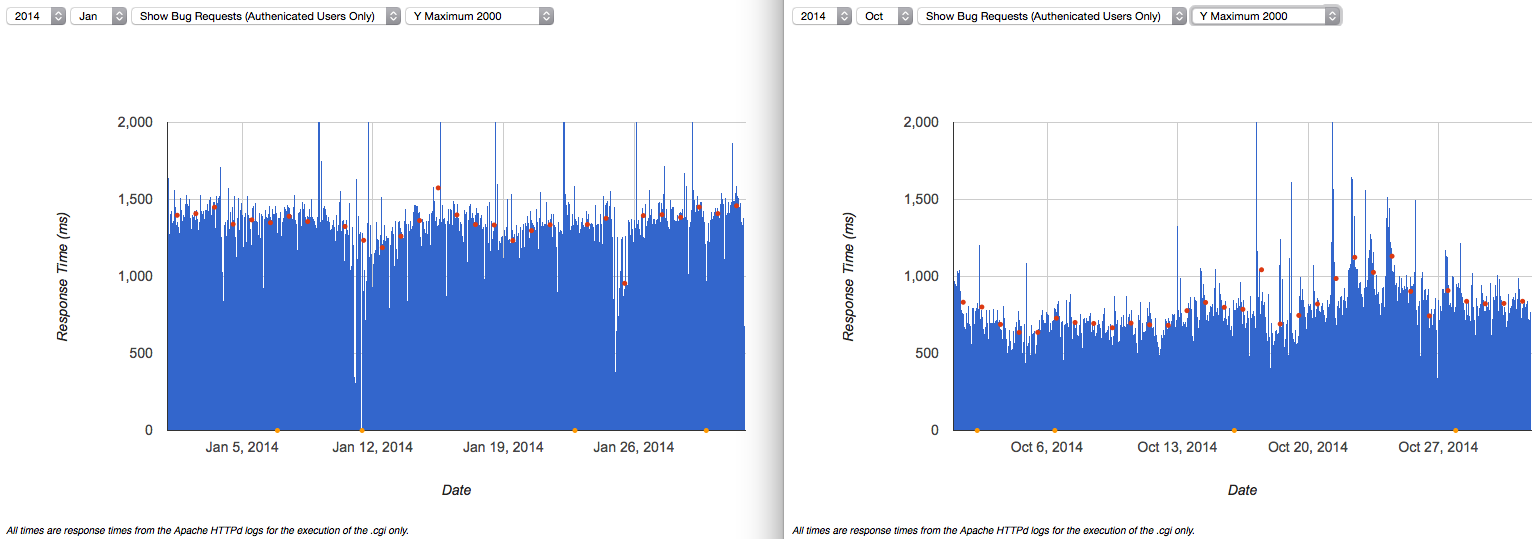The second half of 2014 was spent finishing up some performance work and shifting into usability improvements, which will continue into 2015.
More performance!
By the end of 2014, we’d managed to pick most of the low-to-medium-hanging fruit in the world of Bugzilla server-side performance. The result is approximately doubling the performance of authenticated bug views. Here are graphs from January 2014 and October 2014:

The server now also minifies and concatenates JavaScript and CSS files. This affects cold loads mostly, since these files are cached, but even on reload it saves a few round trips.
As mentioned above, we’re shifting focus away from performance work and towards usability/work-flow improvements, but there will still be perf benefits, both by reducing and delaying loading of content and by making it easier for users to accomplish common tasks.
New, better documentation
We’ve converted the upstream Bugzilla documentation to reStructuredText, massively updated and reorganized it, and, perhaps of most interest to anyone reading this, completely rewrote the API docs, which were very hard to grok.
For BMO specifically, we’ve fixed up the wiki page. We’ve also started a user guide, but it’s just a skeleton at the moment. There are lots of users out there who know the ins and outs of BMO, so feel free to contribute a section!
GMail support
To support Mozilla’s transition to GMail, we added two features. First, we now limit the number of emails sent to a user per minute and per hour, since GMail will temporarily disable accounts that receive too much mail, and some BMO users receive a lot of bugmail. Second, since GMail’s ability to filter mail by headers is limited compared to other email servers, users can now include the X-Bugzilla-* headers in the body via General Preferences.
Other things
-
When entering a new bug, after selecting the product, any relevant custom bug-entry forms are now displayed at the top of the form. We also added a full list of all the custom forms in BMO (linked at the bottom of the bug-entry landing page).
-
There’s now a UI for your Review History (as reviewer).
-
BMO now uses the Fira Sans typeface to improve consistency with other Mozilla web properties, although we reverted to the old monospace style after a lot of negative feedback about Fira’s monospace. If you don’t like Fira, you can always switch to OpenSans by changing your skin in the General Preferences.
-
My Dashboard now has an “Interesting Bugs” query. You can see a full description of the bug criteria in the bug’s user story, but in effect it should be close to what you would receive in bugmail. This is useful on its own if you don’t want to rely on bugmail, but we have plans to make it even more useful by adding weighted scoring to order bugs according to how relevant the changes are to you in particular.
-
There’s now an easy way to generate a shortened link for search URLs, which tend to be long.
-
And just landed yesterday, which is technically 2015 but the result of work done in 2014, is a new look for the guided bug-entry form, aka the Bugzilla Helper, which new BMO users get by default when filing new bugs. It’s the first step of a series of improvements intended to make it easier for new users to file good bugs.
2015!
As I’ve said a few times now, in 2015 we’re going to do a lot of work on improving general BMO-user productivity: usability, UX, work flows, whatever you want to call it. I’ll write more about this later, but here are a few things we’re looking into:
-
Experimenting with alternative bug views. There’s a lot of stuff on the standard bug view. Can we give different windows into the data depending on what the user is trying to accomplish? Can we load this data more intelligently, and organize it more intuitively?
-
A proper field for MozReview links that dynamically loads and displays state information on the review request.
-
Authentication via GitHub. A lot of Mozilla projects are on GitHub, but many use Bugzilla for issue tracking. To make it easier for contributors coming to us via GitHub, we’ll let them log into Bugzilla using their GitHub account.
-
As I wrote about in an earlier post, improved searchability.
As usual, if you have questions or comments, you can leave them here, but an even better place is the mozilla.tools.bmo mailing list, also available as a Google Group and via NNTP.